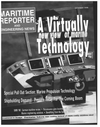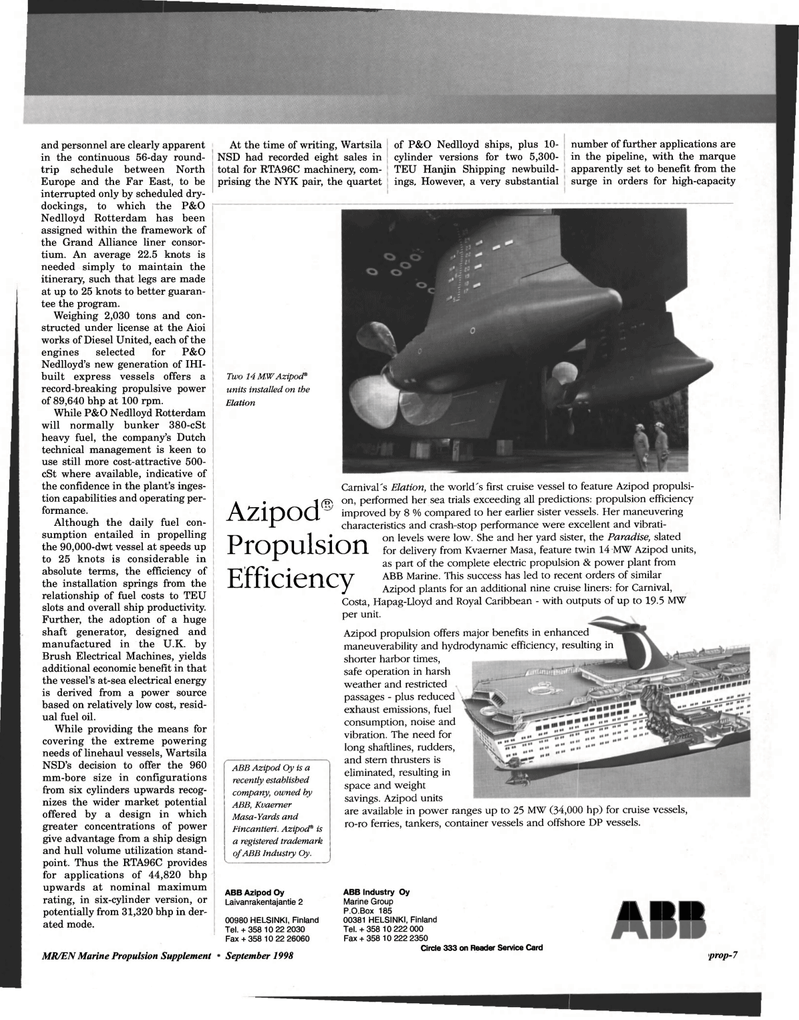
Page 53: of Maritime Reporter Magazine (September 1998)
Read this page in Pdf, Flash or Html5 edition of September 1998 Maritime Reporter Magazine
and personnel are clearly apparent in the continuous 56-day round- trip schedule between North
Europe and the Far East, to be interrupted only by scheduled dry- dockings, to which the P&O
Nedlloyd Rotterdam has been assigned within the framework of the Grand Alliance liner consor- tium. An average 22.5 knots is needed simply to maintain the itinerary, such that legs are made at up to 25 knots to better guaran- tee the program.
Weighing 2,030 tons and con- structed under license at the Aioi works of Diesel United, each of the engines selected for P&O
Nedlloyd's new generation of IHI- built express vessels offers a record-breaking propulsive power of 89,640 bhp at 100 rpm.
While P&O Nedlloyd Rotterdam will normally bunker 380-cSt heavy fuel, the company's Dutch technical management is keen to use still more cost-attractive 500- cSt where available, indicative of the confidence in the plant's inges- tion capabilities and operating per- formance.
Although the daily fuel con- sumption entailed in propelling the 90,000-dwt vessel at speeds up to 25 knots is considerable in absolute terms, the efficiency of the installation springs from the relationship of fuel costs to TEU slots and overall ship productivity.
Further, the adoption of a huge shaft generator, designed and manufactured in the U.K. by
Brush Electrical Machines, yields additional economic benefit in that the vessel's at-sea electrical energy is derived from a power source based on relatively low cost, resid- ual fuel oil.
While providing the means for covering the extreme powering needs of linehaul vessels, Wartsila
NSD's decision to offer the 960 mm-bore size in configurations from six cylinders upwards recog- nizes the wider market potential offered by a design in which greater concentrations of power give advantage from a ship design and hull volume utilization stand- point. Thus the RTA96C provides for applications of 44,820 bhp upwards at nominal maximum rating, in six-cylinder version, or potentially from 31,320 bhp in der- ated mode.
MR/EN Marine Propulsion Supplement
At the time of writing, Wartsila
NSD had recorded eight sales in total for RTA96C machinery, com- prising the NYK pair, the quartet of P&O Nedlloyd ships, plus 10- cylinder versions for two 5,300-
TEU Hanjin Shipping newbuild- ings. However, a very substantial number of further applications are in the pipeline, with the marque apparently set to benefit from the surge in orders for high-capacity
Two 14 MWAzipod® units installed on the
Elation
ABB Azipod Oy
Laivanrakentajantie 2 00980 HELSINKI, Finland
Tel.+ 358 10 22 2030
Fax+ 358 10 22 26060
September 1998
ABB Industry Oy
Marine Group
P.O.Box 185 00381 HELSINKI, Finland
Tel. + 358 10 222 000
Fax+ 358 10 222 2350
Circle 333 on Reader Service Card
A IIII prop-7
Azipod
Propulsion
Efficiency
Carnival's Elation, the world's first cruise vessel to feature Azipod propulsi- ons on, performed her sea trials exceeding all predictions: propulsion efficiency improved by 8 % compared to her earlier sister vessels. Her maneuvering characteristics and crash-stop performance were excellent and vibrati- on levels were low. She and her yard sister, the Paradise, slated for delivery from Kvaerner Masa, feature twin 14 MW Azipod units, as part of the complete electric propulsion & power plant from
ABB Marine. This success has led to recent orders of similar
Azipod plants for an additional nine cruise liners: for Carnival,
Costa, Hapag-Lloyd and Royal Caribbean - with outputs of up to 19-5 MW per unit.
ABB Azipod Oy is a recently established company, owned by
ABB, Kvaerner
Masa-Yards and
Fincantieri. Azipod® is a registered trademark of ABB Industry Oy.
Azipod propulsion offers major benefits in enhanced maneuverability and hydrodynamic efficiency, resulting in shorter harbor times, safe operation in harsh weather and restricted passages - plus reduced exhaust emissions, fuel consumption, noise and vibration. The need for long shaftlines, rudders, and stern thrusters is eliminated, resulting in space and weight savings. Azipod units are available in power ranges up to 25 MW (34,000 hp) for cruise vessels, ro-ro ferries, tankers, container vessels and offshore DP vessels.

 52
52

 54
54
